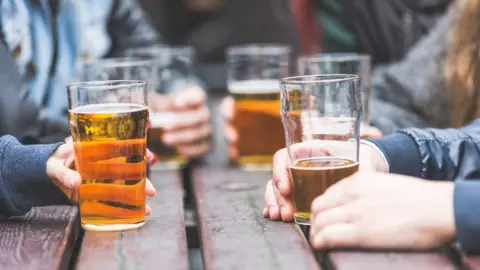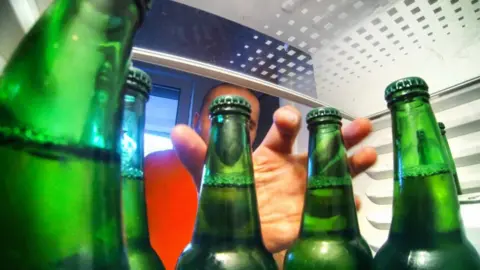Alcohol-linked deaths '54% higher in Scotland'
 Thinkstock
ThinkstockAn average of 22 people a week died from alcohol-related causes in Scotland in 2015, figures show.
The figure is 54% higher than in England and Wales.
NHS Health Scotland looks annually at the nation's relationship with alcohol - bringing together information on sales, price, consumption, deaths and hospital admissions.
Alcohol-related death rates were six times higher in the 10% most-deprived areas than in the 10% least deprived.
The report highlighted inequalities, with alcohol-related stays in hospital nearly nine times higher in the 10% most-deprived areas than in the 10% least deprived areas in 2015/16.
'Harmful consequences'
In 2016, the equivalent of 10.5 litres of pure alcohol were sold per adult in Scotland, representing 20.2 units per adult per week.
Official guidelines advise against men and women drinking more than 14 units a week on a regular basis.
NHS Health Scotland said this meant enough alcohol was sold last year in Scotland for every adult to exceed the weekly guideline by 44% every week of the year.
Sales of alcohol per adult per week were 17% greater in Scotland than in England and Wales - although the rate, which had increased between 2013 and 2015, returned to a similar level as in 2013.
 Getty Images
Getty ImagesThe alcohol-related death rate was more than twice as high in men as in women, with 30 deaths per 100,000 of the population in men compared with 13.8 deaths for women.
Public health intelligence adviser Lucie Giles, lead author of the report, said: "It is worrying that as a nation we buy enough alcohol for every person in Scotland to exceed the weekly drinking guideline substantially.
"This has harmful consequences for individuals, their family and friends as well as wider society and the economy.
"The harm that alcohol causes to our health is not distributed equally; the harmful effects are felt most by those living in the most disadvantaged areas in Scotland.
"Alcohol has become more affordable in recent years as disposable income has increased."
The report's authors also highlighted some "encouraging" findings, with self-reported consumption data showing the proportion of people drinking at harmful levels had fallen while the proportion of non-drinkers had risen.
'Cheap and high-strength'
Meanwhile, the proportion of children reporting drinking in the last week had fallen over time, according to the study.
For 13-year-olds, it dropped from 23% in 2002 to 4% in 2015, and for 15-year-olds from 46% in 2002 to 17% in 2015.
Rates of driving under the influence have fallen consistently over time, from 21.8 per 10,000 population in 2004/05 to 10.2 per 10,000 population in 2015/16.
Public Health Minister Aileen Campbell, said: "This report shows that, whilst some progress has been made in tackling alcohol misuse, we need to do more.
"Over the last few years, more than half of alcohol sold in supermarkets and off-licences was sold at less than 50p per unit and enough alcohol was sold in the off-trade alone to exceed the weekly drinking guideline by a considerable amount.
"That is why we need minimum unit pricing, which will largely impact on the off-trade and will increase the price of the cheap, high-strength alcohol."
Alcohol Focus Scotland chief executive Alison Douglas, said: "Alcohol is so cheap and widely available that it's easy to forget how it can damage our health.
"We need to introduce this long-delayed policy as soon as possible to improve Scotland's health, cut crime and save lives."
